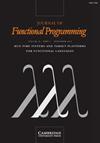Alice or Bob?: Process polymorphism in choreographies
IF 0.6
3区 计算机科学
Q4 COMPUTER SCIENCE, SOFTWARE ENGINEERING
引用次数: 0
Abstract
We present PolyChor爱丽丝还是鲍勃?编排图中的进程多态性
我们介绍 PolyChor $\lambda$ ,这是一种用于高阶函数式编排编程的语言--一种新兴的并发编程范式。在编排式编程中,程序员编写进程系统所需的合作行为,然后将其编译成每个进程的实现,这种转换称为端点投影。与它的前身 Chor $\lambda$ 不同,PolyChor $\lambda$ 在 System F $_\omega$ 的启发下具有类型和进程多态性。也就是说,PolyChor $\lambda$ 是第一种(高阶)功能编排语言,它使程序员能够编写通用编排,并在运行时确定参与者。这种新颖的功能组合还允许 PolyChor $\lambda$ 进程交流分布式值,从而为编写委托提供了一种新的直观方式。虽然与其他一些编排语言相比,PolyChor $\lambda$ 的一些功能特性使其在编排语义与端点投射并发系统之间的对应关系较弱,但我们仍然得到了编排编程的标志性最终结果:投射程序在设计上是无死锁的。
本文章由计算机程序翻译,如有差异,请以英文原文为准。
求助全文
约1分钟内获得全文
求助全文
来源期刊

Journal of Functional Programming
工程技术-计算机:软件工程
CiteScore
1.70
自引率
0.00%
发文量
9
审稿时长
>12 weeks
期刊介绍:
Journal of Functional Programming is the only journal devoted solely to the design, implementation, and application of functional programming languages, spanning the range from mathematical theory to industrial practice. Topics covered include functional languages and extensions, implementation techniques, reasoning and proof, program transformation and synthesis, type systems, type theory, language-based security, memory management, parallelism and applications. The journal is of interest to computer scientists, software engineers, programming language researchers and mathematicians interested in the logical foundations of programming.
 求助内容:
求助内容: 应助结果提醒方式:
应助结果提醒方式:


